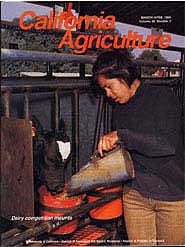


University of California
California Agriculture
|
|||
|
|||

Dairy competition mounts
Cover:
With competition rising, some dairies are using specialized labor as a management technique.
March-April 1994
Volume 48, Number 2 News and opinion |
|||
|
University of California, 1301 S. 46th St., Bldg. 478 Richmond, CA
|